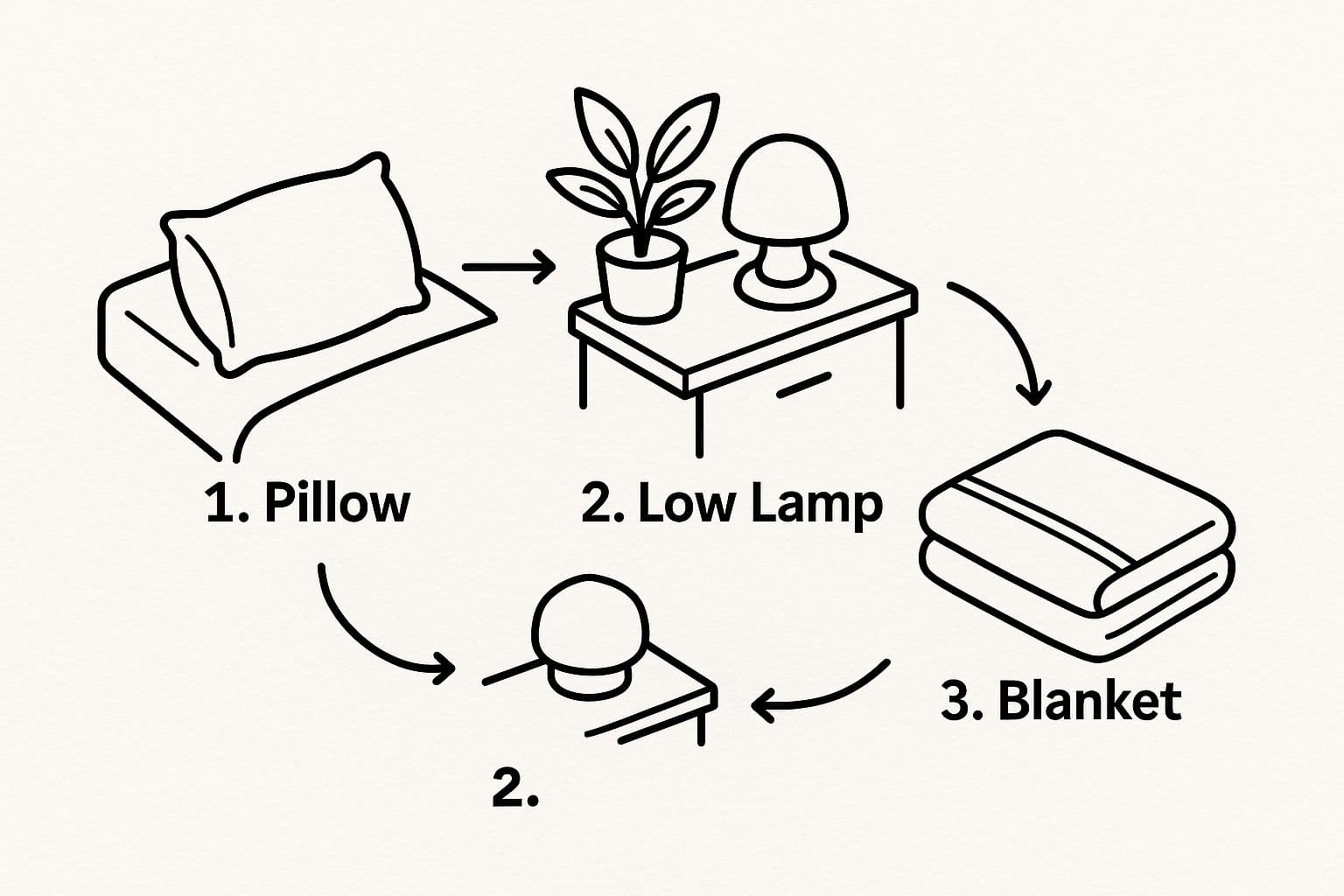Sleep Meditation for Beginners Guide
Tired of tossing and turning? Our sleep meditation for beginners guide offers simple, effective techniques to calm your mind and achieve deep, restful sleep.
If you're tired of battling racing thoughts when your head hits the pillow, you've landed in the right place. Getting started with sleep meditation isn't about forcing your mind to go blank—that's a common myth. It's really about gently shifting your focus away from the day's anxieties, using simple tools like your breath or a guided story to calm your nervous system and pave the way for deep, restorative sleep.
Why Sleep Meditation Actually Works, Even for Beginners

Many people think meditation requires years of hardcore discipline, but the core idea is surprisingly simple: awareness without judgment. Instead of fighting those restless thoughts, you learn to notice them, almost like clouds passing in the sky, and then gently guide your attention back to a calm anchor. This could be the feeling of your breath or the sound of a soothing voice.
This simple act of redirection is what breaks the cycle of stress and worry that so often keeps us wide awake at night.
And it's an approach that's catching on. Around 275 million people worldwide now practice meditation, with countless beginners turning to it specifically to improve their well-being and, of course, their sleep. If you're curious about the global trend, MindfulnessBox.com offers some fascinating data on meditation's growing reach.
Setting Realistic Expectations From The Start
One of the biggest hurdles for anyone new to this is the pressure to "do it right." Let's get one thing straight: the goal is not to achieve a perfectly silent mind on your first night. Or any night, for that matter.
Your mind will wander. That’s what minds do. The real practice—the part that builds the muscle—is in noticing when it has wandered and kindly, without frustration, bringing it back.
The true victory in beginner meditation isn't achieving silence, but rather cultivating the patience to begin again each time your mind strays. This builds mental resilience that translates directly to better sleep.
To set you up for success, it helps to know what you’re actually aiming for versus what the common misconceptions are. This simple shift in perspective can make learning sleep meditation feel less like a chore and more like a comforting nightly ritual.
Beginner Meditation Goals vs Common Misconceptions
This table breaks down the key differences between a healthy starting mindset and the myths that can trip you up.
Your Goal (What to Focus On) | Common Misconception (What to Ignore) |
Gently noticing when your mind wanders. | Forcing your mind to be completely empty and silent. |
Consistently practicing for 5-10 minutes a few nights a week. | Believing you need to meditate for an hour every single night to see benefits. |
Feeling a bit calmer or more relaxed than when you started. | Expecting to fall asleep instantly or cure insomnia overnight. |
Following the guidance of a voice or focusing on your breath. | Thinking there is a "perfect" posture or that you're "failing" if you fidget. |
Bringing a kind, patient attitude to the process. | Getting frustrated or judging yourself when you get distracted. |
Getting this mindset right from the get-go is your first real step. It turns the entire process from a pass/fail test into a gentle practice of self-compassion, which is exactly what your tired mind needs.
Setting the Stage for Sleep
Your bedroom isn't just a place you happen to sleep; it's a space that actively sends signals to your brain. It can either cue your mind for deep, restorative rest or keep it wired for wakefulness. Before you even think about starting a meditation, take a few minutes to transform your room into a genuine sleep sanctuary. This is about more than just flipping off a switch.
First, let's talk temperature. It might sound obvious, but a cool room is a non-negotiable for good sleep. Research points to a sweet spot between 60 and 67 degrees Fahrenheit (15-19°C). When your room is too warm, it can actually fight against your body's natural pre-sleep temperature dip, which is a crucial biological trigger for falling asleep.
Next, you need to wage a war on light. Even the tiniest sliver of light from under a door, a blinking charger, or a streetlamp can mess with your circadian rhythm.
Master the Darkness and Quiet
Blackout curtains are a game-changer for blocking out the world. They create a dark, cave-like atmosphere that practically screams "it's time to sleep" to your brain. For those pesky little lights from electronics, a small piece of electrical tape is an incredibly simple and effective fix. Your goal is absolute darkness.
Sound can be just as disruptive as light, especially if you live somewhere noisy. A white noise machine is a great way to mask inconsistent sounds like passing cars or loud neighbors, creating a steady, predictable hum. For a cheaper but equally effective solution, simple foam earplugs work wonders. Taking control of what you see and hear is a foundational part of preparing for sleep meditation for beginners.
A huge piece of this puzzle is what I call the ‘digital sunset.’ This means putting away all screens—phones, tablets, TVs—at least an hour before you plan to meditate.
The blue light blasting from these devices actively suppresses melatonin, the hormone your body needs to feel sleepy. Instead of scrolling through your phone, try one of these screen-free wind-down activities. They signal to your brain that the day is officially over.
Read a physical book (an e-reader without a backlight is okay too).
Listen to some calm music or a relaxing podcast.
Journal for a few minutes to offload any nagging thoughts.
By turning your room into a cool, dark, and quiet haven, you're laying the perfect groundwork for a much more successful and deeply restorative meditation practice.
Simple Breathing Techniques to Start Tonight
Your breath is the most powerful and immediate tool you have for calming a busy mind. This makes it the perfect place to start your sleep meditation for beginners. The best part? You don't need any special gear or past experience. You just need to breathe with intention.
It's a surprisingly simple concept: when you consciously slow your breathing, you send a direct signal to your parasympathetic nervous system that it's safe to rest. This small action helps lower your heart rate, eases muscle tension, and sets the stage for sleep. A little tip I've found helpful is to place one hand on your belly. Feeling its gentle rise and fall gives your wandering mind a physical anchor to focus on.
Creating a calm physical space is just as important as these mental exercises, as this visual guide shows.

As you can see, a serene, uncluttered room is the foundation for a peaceful mind.
The 4-7-8 Breathing Technique
One of the most effective methods I’ve come across is the 4-7-8 technique. It's celebrated for its deeply tranquilizing effect and acts almost like a natural sedative for your entire nervous system.
Here’s how you do it:
Start by exhaling completely through your mouth, making a gentle whoosh sound.
Close your mouth and inhale quietly through your nose to a slow count of four.
Hold your breath for a count of seven.
Exhale completely through your mouth—making that whoosh sound again—for a count of eight.
Repeat this cycle three more times, for a total of four full breaths.
The real magic of the 4-7-8 breath is in the extended exhale. This long, slow release fully empties the lungs and triggers a profound relaxation response that you can feel almost instantly.
Effortless Box Breathing
Another fantastic technique, especially if your mind feels particularly scattered, is Box Breathing. It’s also known as four-square breathing because its symmetrical pattern is incredibly grounding and easy to remember. Just picture tracing a box in your mind as you go.
Inhale through your nose for a count of four.
Hold your breath for a count of four.
Exhale through your mouth for a count of four.
Hold your breath again for a count of four.
Just repeat that simple pattern for a few minutes. If you find the counts are a bit much at first, just adjust them to whatever feels comfortable for you. The goal is rhythm, not perfection.
To take your relaxation even deeper, try pairing these exercises with some calming nature sounds for sleep. The gentle sound of rain or a crackling fire can help mask distracting noises and make your space feel even more peaceful.
Finding the Right Guided Meditations

You don’t have to go it alone when you're just starting out with sleep meditation. In fact, following a guided audio track is a game-changer for beginners. It gives your mind a gentle voice to anchor to, which is a lifesaver when you're trying to keep your brain from spiraling into its usual late-night loop of stressful thoughts about work, family, or that endless to-do list.
Think of it as having a friendly guide leading you down a quiet path toward tranquility. The great news is there's a huge variety of styles to explore, so you can find what genuinely works for you.
This practice is getting more popular by the day. In the United States alone, about 20% of adults say they practice some form of meditation or mindfulness, often to get better sleep. This demand fuels a massive market for wellness apps, which just goes to show how many people are finding real value in guided audio. You can dig into the meditation app market trends over on Statista if you're curious.
Popular Types of Guided Sleep Meditations
Not all guided meditations are created equal. Finding the right fit is a personal journey and often comes down to what your mind needs on any given night.
Body Scan Meditations: These guide your attention gently through your body, from your toes all the way to the top of your head. This process is incredibly effective for releasing stored physical tension you might not even realize you’re holding onto. It’s a fantastic way to reconnect with your body and let go of the day's stress.
Visualization Exercises: This style invites you to paint a picture of a peaceful scene in your mind, like a quiet beach at sunset or a serene, sun-dappled forest. By engaging your imagination, you mentally transport yourself far away from your bedroom and into a state of deep, restorative calm.
Here's a key takeaway, especially for beginners: the voice and pacing of the narrator are everything. If you find a voice grating or the background music distracting, don't force it. Move on and try another. The whole point is to find comfort and relaxation, not to create another chore for yourself.
Another wonderfully effective option is the sleep story. These are softly spoken narratives designed to engage your mind just enough to stop it from wandering, but not so much that they keep you awake. The gentle plots and calm delivery are crafted specifically to help you drift off naturally.
If that sounds intriguing, our complete guide to sleep stories for adults is a great place to start exploring.
The Science Behind Meditation and Sleep
Ever lie in bed, mind buzzing, and wonder what's actually happening in your brain when you try to meditate? It’s not just wishful thinking. There's some real science explaining how sleep meditation can guide you from a state of wired alertness into a deep, restorative calm. It works on a physiological level to get your body truly ready for rest.
When you meditate, you’re actively hitting the brakes on your body's stress response. This helps dial down the levels of cortisol, often dubbed the "stress hormone," which is a major culprit behind a racing mind at night. A calmer state, in turn, allows for the natural production of melatonin—the hormone that gives your body the green light for sleep.
Shifting Your Brainwaves
Meditation also has a fascinating, direct effect on your brain's electrical activity. During a busy day, your brain is typically firing on all cylinders, operating in active beta waves. Sleep meditation gently coaxes your brain to shift into slower, calmer brainwave states.
It's a subtle but powerful transition.
Alpha Waves: These are linked to a state of quiet wakefulness and non-arousal. Think of that feeling when you're just quietly daydreaming.
Theta Waves: These are even slower and pop up during deep relaxation, drowsiness, and the very first stages of sleep.
This gentle shift in brain activity is what makes letting go of the day feel not just possible, but natural. Many people find that pairing this process with ambient sounds can make it even more effective. If that sounds interesting, you can learn more about using wind noise for sleep in one of our other guides.
The proof is in the research. A major review of 18 different trials found that mindfulness meditation measurably improves sleep quality when compared to other non-specific activities.
This body of research really underscores that using sleep meditation for beginners isn't just a hopeful guess—it's a technique backed by solid, positive results. To get into the weeds of the science, you can read the full research on meditation and sleep quality.
Common Questions About Sleep Meditation
When you first dip your toes into sleep meditation, you’re bound to have some questions. It's totally normal. You might wonder if you're "doing it right" or what to expect. Let's walk through some of the most common thoughts and worries that come up, so you can start your practice feeling confident and at ease.
One of the first hurdles for many is the fear of nodding off too soon. "What if I fall asleep during the meditation?" My simple answer is—great! If you're using meditation specifically for sleep, falling asleep is a success story. Don't stress about hearing the end of the audio. The meditation did its job perfectly by guiding you into slumber.
Another big question is about the timeline. People often ask, "How long until I see results?" This isn't a magic pill. While some people feel a noticeable difference after just one night, for many others, the benefits are more like a slow sunrise—they build gradually over time. Think of it less as a single, perfect session and more as building a new, healthy habit for your mind.
The real purpose of sleep meditation isn't to force a perfect outcome every night. It's about creating a consistent, gentle ritual that signals to your mind and body that it's time to rest and let go of the day.
Even a short practice of just 5-10 minutes, a few times a week, can start to retrain your body's relaxation response.
Handling Common Hurdles
It's almost a guarantee that when you start, your mind will feel like a busy highway. You're probably thinking, "My thoughts keep distracting me, am I failing?" Absolutely not. This is perhaps the biggest misconception. Your brain is a thought-machine; that's its job.
The practice isn't about shutting your thoughts off completely—that's impossible. It's about gently noticing when your mind has wandered and, without judgment, kindly bringing your focus back to your breath or the narrator's voice. Every single time you do this, you're building your "focus muscle."
Finally, what about timing? People wonder, "Is there a best time to meditate for sleep?" For this specific type of meditation, the answer is simple: right as you get into bed, ready to drift off. Make it the very last thing you do. Teeth brushed, lights out, phone silenced. This helps create a powerful mental shortcut: meditation means sleep is on its way.
A few key takeaways to hold onto:
A wandering mind is part of the process. The real practice is in the gentle act of returning your focus.
Falling asleep is the goal. It's a clear sign that the technique is working for you.
Consistency beats duration. A short, regular practice is far more powerful than a long, occasional one.
Understanding these points helps you approach your sleep meditation for beginners practice with the patience it deserves. You’re not trying to win a race; you’re learning to rest.
Ready to drift away to a new world tonight? At Otherworld Tales, we create immersive, fantasy-inspired bedtime stories and guided meditations for adults. Mix in calming sounds like rain or wind to create your perfect sleep sanctuary. Start your free journey at Otherworld Tales.